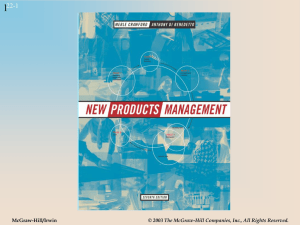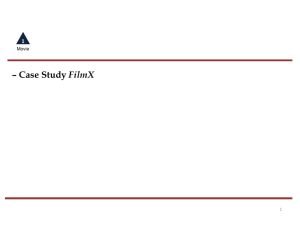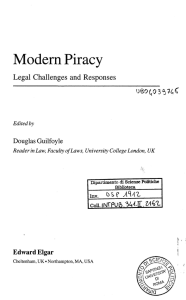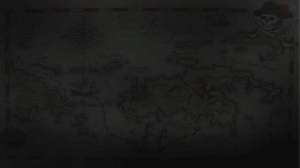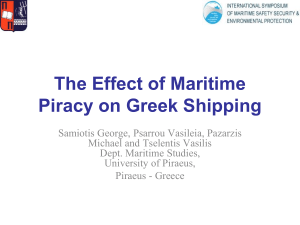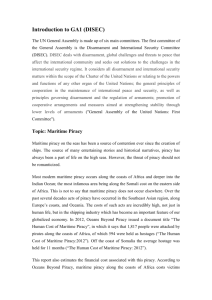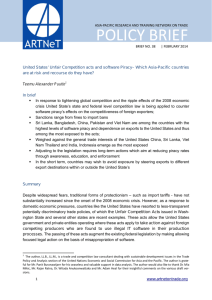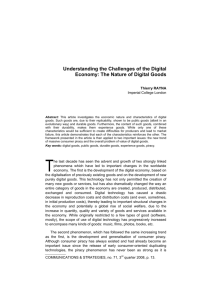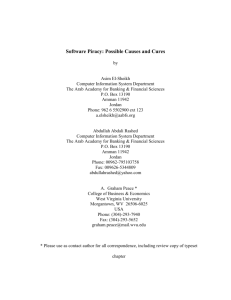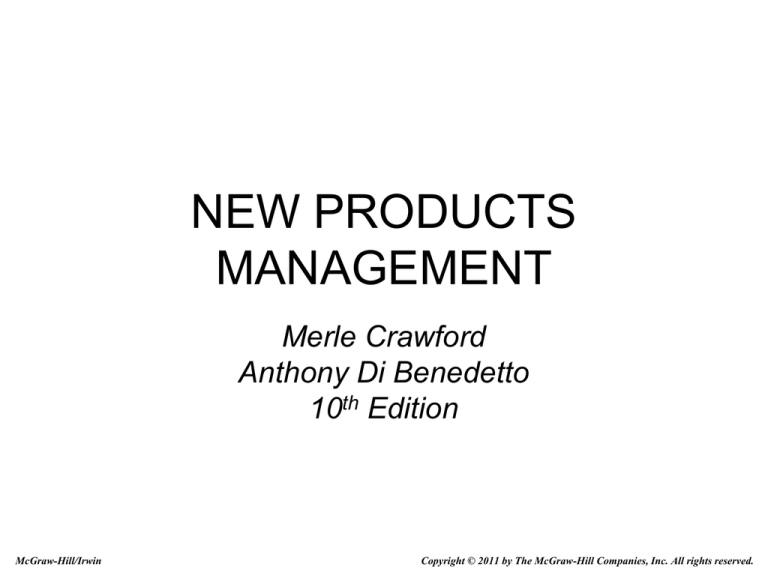
NEW PRODUCTS
MANAGEMENT
Merle Crawford
Anthony Di Benedetto
10th Edition
McGraw-Hill/Irwin
Copyright © 2011 by The McGraw-Hill Companies, Inc. All rights reserved.
Chapter 20
Public Policy Issues
20-2
Public Policy Concerns
• Product developers have to be aware of
emerging public policy concerns and consider
their impact on product development and
launch.
• How do the following affect product decision
making?
– Concern about the environment and the results of
climate policy, government mandates on fuel
emission, etc.
– Concern about poor diets leading to heart disease,
high cholesterol and diabetes, including among young
people.
20-3
Life Cycle of a Public Concern
• Stirring
• Trial Support
• Political Arena
• Regulatory Adjustment
20-4
Product Liability:
Typology of Injury Sources
• Inherent Risk in Product
• Design Defects
–
–
–
Dangerous Condition
No Safety Device
Inadequate Materials
• Defects in Manufacture
• Inadequate Instructions or Warnings
• Dangers After Use
20-5
Four Legal Bases for Product
Liability
• Negligence
– Manufacturer let the product be injurious
• Warranty
– A promise
– Express warranty: a statement of fact about a product
– Implied warranty: arises when product is made available for a
given use
20-6
Four Legal Bases for Product
Liability (continued)
• Strict Liability
– Seller is responsible for not putting a defective product on the
market
– Defenses: assumption of risk; unforeseeable misuse; not
defective
• Misrepresentation
– Implied use of product, even if not defective
Other Legislation
Consumer Product Safety Act/Safety Commission
20-7
Which Are the Real Product Warning Labels?
1. On a disposable razor: “Do not use this product during an earthquake.”
2. On a rock garden: “Eating rocks may lead to broken teeth.”
3. On a roll of Life Savers: “Not for use as a flotation device.”
4. On a hair dryer: “Do not use while sleeping.”
5. On a piano: “Harmful or fatal if swallowed.”
6. On a cardboard windshield sun shade: “Warning: Do not drive with sun shield in place.”
7. On shin guards: “Shin guards cannot protect any part of the body they do not cover.”
8. On syrup of ipecac: “Caution: may induce vomiting.”
9. On an iron: “Do not iron clothes while being worn.”
10. On a plastic sled: “Not to be eaten or burned.”
11. On work gloves: “For best results, do not leave at crime scene.”
12. On a cell phone: “Don’t try to dry your phone in a microwave oven.”
13. On a carpenter’s router: “This product not intended for use as a dentist’s drill.”
14. On a blender: “Not for use as an aquarium.”
15. On a stroller: "Always remove child from stroller before folding.“
16. On a washing machine: “Do not put any person in this washer.”
17. On a fireplace log: “Caution – risk of fire.”
18. On a laser printer cartridge: “Do not eat toner.”
20-8
Which Are the Real Product Warning Labels?
1. NO
2. On a rock garden: “Eating rocks may lead to broken teeth.”
3. NO
4. On a hair dryer: “Do not use while sleeping.”
5. NO
6. On a cardboard windshield sun shade: “Warning: Do not drive with sun shield in place.”
7. On shin guards: “Shin guards cannot protect any part of the body they do not cover.”
8. NO
9. On an iron: “Do not iron clothes while being worn.”
10. On a plastic sled: “Not to be eaten or burned.”
11. NO
12. On a cell phone: “Don’t try to dry your phone in a microwave oven.”
13. On a carpenter’s router: “This product not intended for use as a dentist’s drill.”
14. NO
15. On a stroller: "Always remove child from stroller before folding.“
16. On a washing machine: “Do not put any person in this washer.”
17. On a fireplace log: “Caution – risk of fire.”
18. On a laser printer cartridge: “Do not eat toner.”
20-9
Preparing For the Product Recall
• Prior to the Recall
– Designate the recall program coordinator
(spokesperson)
– Develop channels for communicating with customers
directly
• During the Recall
– Assess safety risk and take corrective action
– Inform customers as well as intermediaries of the
risks
• After the Recall
– Strive to restore company reputation
– Monitor recall effectiveness
20-10
Public Policy Problems and the
New Products Process
20-11
Other Areas of Public Policy
Debate
•
•
•
•
•
•
Environmental Needs
Product Piracy
Worthy Products
Morality
Monopoly
Personal Ethics (what would you do?)
20-12
Environmental Needs
• A new product is said to hurt the environment if:
– Its raw materials are scarce or hard to get to.
– Its design or manufacture causes pollution or excess power
usage.
– Its use causes pollution.
– Its disposal cannot be handled by recycling.
• Some companies test market their products in Germany and
Scandinavia, because of the strict greenness tests there.
• Business objectives should be aligned with environmental initiatives,
otherwise product teams will not feel supported in pursuing projects
with real environmental benefits.
• Taking a leadership position in green product development could
turn out to be a sustainable competitive advantage.
20-13
Product Piracy
• Threatens brand equity and intellectual property
of firms.
• Categories of product piracy:
– Counterfeiting: unauthorized production of goods
– Brand Piracy: unauthorized use of copyrights or
patented brands (the “$20 Rolex”)
– Near Brand Usage: slightly different brand names
(“Tonny Hilfiger” clothes)
– Intellectual Property Copying: Unauthorized copying
of CDs and DVDs, for example
20-14
Protection Against Product Piracy
•
•
•
•
•
•
•
Communication
Legal recourse
Government
Direct contact
Labeling
Strong proactive marketing
Piracy as Promotion
Source: Laurence Jacobs, A. Coksun Samli, and Tom Jedlik, “The Nightmare of International Product Piracy,” Industrial
Marketing Management 30, 2001, pp. 499-509.
20-15
Worthy Products
• Coffee manufacturers agreed to produce
some brands containing no beans from El
Salvador.
• Manufacturers have been asked to
produce special exercise equipment for
the handicapped or modified products for
the elderly.
• Orphan drugs supported by the federal
government; otherwise would not be
commercially feasible due to few users.
20-16
Personal Ethics – What Would You
Do?
1.
2.
3.
4.
5.
6.
You introduce a temporary product and are told not to let distributors or your sales
force know it is only temporary and will soon be replaced.
You are marketing a new seminar service to train bank personnel in investment
counseling, but you don’t know they will really learn how to counsel.
You are working on an item to be sold to virtually every K-12 school. You calculate
gross margin at about 80%. The price could be cut in half and your company
margin would still be 60%.
Your database service collects patient records from physicians and offers a new
service of information for pharmaceutical firms, including patients’ name, age, sex,
and so on, as well as illnesses and treatments.
Your company’s “educational” game cards are known to be bought by less
sophisticated parents: there are several far better games on the market.
Your brewing company markets a new beer containing legal (sterilized) hemp
seeds, mostly as a gimmick. Nevertheless, your advertising contains obvious drug
imagery.
20-17
What Can the New Product
Manager Do?
• Include in Strategy and Policy
– Consider public policy implications in PIC
• Control Systems
• Product Testing
• Marketing Prepares Warnings/Labels
• Adequate Market Testing (to identify
miscommunications)
• Education (to company personnel and customers)
• External Affairs
20-18

